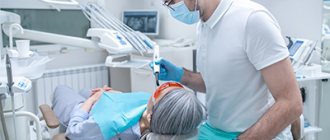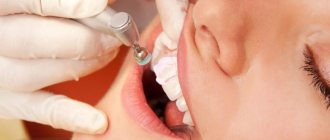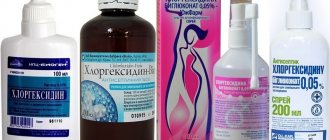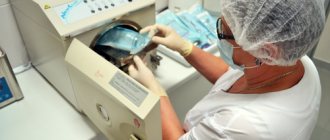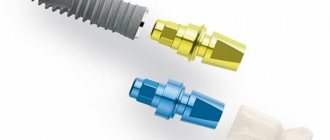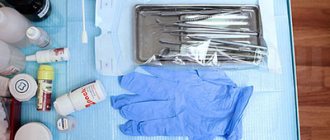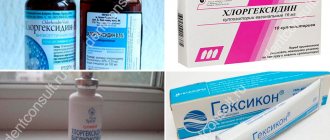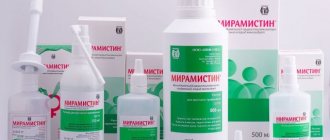One of the most important problems of medical institutions is nosocomial infections. Infection can occur during treatment and diagnostic procedures, as well as naturally - through household contact or airborne droplets. We do not undertake to estimate the frequency and volume of nosocomial infections, but we can talk in detail about those disinfectants that are used in modern medical practice.
In order to prevent the spread of nosocomial infections, modern chemical agents are used to disinfect hospitals based on chlorine, hydrogen peroxide, alcohols, aldehydes and other disinfectants. Their active use for disinfection of premises, medical instruments, and equipment reduces the risk of infection to almost zero. However, the very concept of “disinfection” is somewhat broader than a list of disinfectants and methods of their use. There are other methods of disinfection other than chemical disinfection.
Disinfection methods
Disinfection is a list of chemical, mechanical, and physical manipulations specifically designed to destroy pathogenic agents that cause various diseases in humans and animals.
Disinfection is carried out using the following methods:
- boiling;
- ultraviolet irradiation;
- air ozonation;
- steam, air sterilization;
- treatment with chemical disinfectants.
Depending on the time and place of disinfection, disinfection is divided into:
- Preventive disinfection - carried out if the exact source of infection cannot be identified or does not exist, to protect against possible infection.
- Focal disinfection - performed when the source of infection is identified.
Focal disinfection includes: current treatment, which is carried out in the presence of the patient, and final treatment, which is carried out after the patient leaves (discharge or death) to eliminate foci of the pathogen.
All medical instruments, equipment, surfaces and objects with which the patient has been in contact are subject to chemical disinfection or another disinfection method. Disinfection of surgical instruments followed by sterilization is mandatory.
Routes of transmission of nosocomial infections in dentistry
The normal level of sterility in a dental office should approximate the level of sterility in a surgical office. But since in practice this is far from the case, there are many ways of transmitting nosocomial infections (HAI):
- Contact – through the hands of employees and poorly processed tools;
- Airborne - after visiting each patient, a tiny suspension of medications, bone dust, saliva and blood is formed in the air of the office.
An aerosol, impregnated with microflora from the patient’s oral cavity, covers the equipment, walls and interior items, creating all the conditions for infection and the development of infections among visitors to the dental office.
Disinfectants
Disinfectants used in medicine are classified according to their composition and purpose. They have varying degrees of antimicrobial activity, toxicity, and influence on the object they treat. The following modern disinfectants are officially approved for use in medical institutions:
- Based on chlorine: Chlormisept economy. These products are used to disinfect medical instruments made of plastic, rubber, and glass. Chlorine-containing preparations have low toxicity, but cause corrosion of metals. Among the disadvantages is the presence of the smell of chlorine.
- Hydrogen peroxide solutions: Alphadez oxy. They have low toxicity, are odorless, and are used to disinfect instruments made of rubber, plastic, and glass. Does not have a fixing effect on organic matter.
- Aldehydes: Alfadez forte, Alfadez ortho. They are used for disinfecting endoscopes and related instruments, as well as for cleaning premises and washing equipment. They have high activity against many pathogenic microbes. Aldehyde agents are often used for HLD and chemical sterilization, but they have a fixing effect and therefore require careful pre-cleaning and disinfection.
- Alcohol-containing antiseptics: Miroseptic, Ecobriz antiseptic, Estilodez antiseptic. Used as an antiseptic for treating the skin before injection, for disinfecting the skin and surgical fields.
All objects in contact with blood and in contact with the wound surface are subject to mandatory disinfection. Sterilization of medical instruments is carried out after their preliminary disinfection using chemical solutions or steam sterilization.
Children's Clinic Khimki
1. Definition of the concept : disinfection, deratization, disinfestation.
Types, methods and means of disinfection.
2. Advantages and disadvantages of various groups of disinfectants.
Safety rules when working with disinfectants.
Rules for storing chlorine-containing solutions.
The student must be able to:
1. Carry out wet cleaning of health care facilities using a disinfectant solution.
2. Carry out ventilation and quartz treatment of health care facilities.
3. Monitor the sanitary condition of rooms, bedside tables, and refrigerators.
Prepare disinfectant solutions of various concentrations.
Provide first aid if chlorine-containing solutions come into contact with the skin and mucous membranes.
Disinfect patient care items, linen, and instruments.
Disinfect and dispose of used disposable medical instruments.
Have skills:
1. Preparation of chloramine solutions of the required concentration.
2. Disinfection of disposable syringes.
Self-study assignments
1. Answer the following questions:
1. What definition can you give to such concepts as disinfection, deratization, disinsection, bactericidal, virucidal, disinfectants, infection control.
2. What types of disinfection do you know?
3. What disinfection methods do you know?
4. What active disinfectants are used in health care facilities?
5. What properties should disinfectants have?
6. What safety precautions must be observed when preparing and working with disinfectants?
7. What is first aid if chlorine-containing products come into contact with the skin, mucous membranes, or respiratory tract?
8. How is wet cleaning carried out in a health care facility?
9. How to prepare working solutions of chloramine?
10. How to prepare a 10% basic bleach solution?
11. How to prepare working solutions of bleach of different concentrations?
12. How are disposable syringes disinfected and disposed of?
13. How to disinfect patient care items (dishes, linens, heating pads, ice packs, thermometers, enema tips, spatula)?
14. How many times are ventilation and quartz treatment carried out in healthcare facilities?
15. How is the sanitary condition of rooms, bedside tables, and refrigerators monitored?
16. What is the shelf life of clarified, stock solution of bleach and chloramine, modern disinfectants?
Brief theoretical overview
Definitions on this topic:
1. Disinfection (disinfection ) is the destruction of pathogenic and opportunistic microorganisms in the human environment, on equipment and medical instruments in a medical institution.
2. Disinsection - (Latin “des” - destruction, Latin “insectum” - insect) is a set of measures aimed at exterminating arthropods that are carriers of infectious diseases.
3. Deratization – (French “deratisation” from “rat” - rat) is a set of measures aimed at combating rodents that are carriers of infectious diseases.
4. Bacteriostaticity is the property of agents of a physical, chemical and biological nature to prevent the proliferation of bacteria.
5. Bactericidal – the property of agents of a physical, chemical and biological nature to cause the death of bacteria.
6. Virucidity – the ability of a chemical or physical factor to cause the death of viruses.
7. Disinfectants are chemical substances of various origins, compositions and purposes that cause the death or suspension of the vital activity of microorganisms.
8. Exposure time – the period of time for the onset of disinfection (sterilization).
9. Infection control is a system of organizational, preventive and anti-epidemic measures aimed at preventing the spread of infectious diseases in the hospital, and based on the results of epidemiological diagnostics.
Types of disinfection
1. Preventive disinfection is carried out as a precautionary measure in the absence of a source of infection. A distinction is made between routine disinfection and general cleaning of hospital premises.
2. Focal ( in the presence of a focus of infection) - anti-epidemic is carried out in the event of an infectious disease or suspicion of it.
3.Depending on the time of the event it is divided:
A) Current – carried out at the source of infection, at the bedside of an infectious patient in a healthcare facility or at home, and is carried out repeatedly.
B) Final – carried out once after isolation, hospitalization in the infectious diseases department, discharge or death of the patient in order to completely free the infectious focus from pathogens.
Disinfection methods
1. Mechanical - based on the removal of pathogens of infectious diseases from objects (complete removal is not achieved, but the concentration is reduced):
· wet cleaning of the premises;
· beating out clothes, bed linen and bedding;
· hand washing in a social, hygienic, surgical way;
· through ventilation, washing, washing, vacuuming.
2. Physical – based on the influence of a number of physical factors:
· burning of garbage and items of no value,
· treatment with boiling water or heating to a boil;
· ironing with a hot iron, firing, calcination;
· boiling in distilled water – 30 minutes, with the addition of baking soda – 15 minutes;
· exposure to dry hot air, saturated water steam under pressure;
3. Chemical - based on the use of chemicals (antiseptics, disinfectants) by methods of irrigation, wiping, immersion or soaking, falling asleep with a dry preparation.
4. Combined - combining the use of several of the above methods (for example, wet cleaning of premises followed by ultraviolet irradiation). You cannot use disinfectants for wiping: sidex, formalin, glutaral, bianol, dezoxon - 1, as they have toxic side effects.
Disinfectants used in health care facilities, their classification.
Disinfectants used in health care facilities are divided into 3 main groups according to their intended purpose:
1) For disinfection of medical products;
2) For disinfection of premises, furnishings and patient care;
3) Antiseptics for treating the hands of medical staff.
Only those disinfectants that are officially approved by the Department of State Sanitary and Epidemiological Supervision of the Ministry of Health of Russia, registered with the Bureau of Registration of Medicines and for which there are Certificates of State Registration, a certificate of conformity of the GOST system and Guidelines for use approved by the Department of State Sanitary and Epidemiological Supervision of the Ministry of Health of Russia can be used in health care facilities. Currently, 242 disinfectants and sterilization products of various chemical groups are approved for use.
Chemical disinfectants must meet a number of requirements:
Currently, the industry produces about 300 disinfectants. For disinfection in health care facilities, you can use only products that have passed control and are officially approved for use.
Features of modern disinformation. funds:
1. Wide spectrum of action and activity against bacteria, viruses, fungi;
2. Economical use: working solutions can be used for a long time and repeatedly;
3. Storage stability, ease of use (prepared from tablets or liquid concentrate);
4. Low toxicity to people, no damaging effect on materials;
5. Additional actions: washing, deodorizing;
Flaws:
1. Ineffective against some viruses, does not destroy spores
2. Lose their activity in the presence of organic contaminants
For disinfection, disinfectants from the following chemical groups are allowed for use: chlorine-containing agents, products based on hydrogen peroxide, based on alcohols, aldehydes, cationic surfactants.
- Chlorine-containing compounds: Desam, Dichlor-1, Chlorcin - powders with the smell of chlorine, do not spoil the objects being disinfected, are stable, low-toxic, approved for sale to the public; Precept - tablets, granules, have low toxicity, rapid action, and are easy to use. Chlorine-containing products are intended for disinfection of products made of corrosion-resistant metals, rubber, plastics, and glass.
— Cationic surfactants (surfactants): this group includes quaternary ammonium compounds (Alaminol, Deconex, Dulbak), amine salts, guanidine derivatives. Preparations in this group have a cleaning effect, are odorless, and non-toxic. They are often used in combination with other means. Polymer derivatives of guanidines - Likotsid, Intertsid - form a bactericidal film on the surface. retaining its properties for up to 6 months. The disadvantages of this group are that they do not act on some viruses and fungi.
— Alcohol-containing compounds – have a rapid action. Ethyl alcohol is most often used in 70% concentration. Used to disinfect skin during injections. Alcohol-based products are used as skin antiseptics. The use of alcohol is recommended only for disinfecting metal instruments. To disinfect products not only made of metals, but also other materials, products based on alcohols and cationic surfactants are approved for use: Gibitan, Veltosept. Products containing alcohols have the property of fixing contaminants of organic origin, which necessitates the need to first wash contaminated products in water before disinfection in compliance with anti-epidemic measures.
— Products based on hydrogen peroxide: Hydrogen peroxide, a colorless transparent liquid, is a strong oxidizing agent, due to which it destroys microorganisms. Advantages: odorless, environmentally friendly, can be used for PSO and sterilization. Disadvantage: unstable, stored for no more than 2 days (it is better that the solution temperature is about 50 C, then the activity of hydrogen peroxide increases); paints may become discolored when exposed to hydrogen peroxide; Inhalation exposure to hydrogen peroxide and contact with skin is dangerous. Products based on hydrogen peroxide (hydrogen peroxide with 0.5% detergent, Peroximed, PVC, etc.) are intended for disinfection of products made of corrosion-resistant metals, rubber, plastics, glass.
— Aldehydes: have a gentle effect on materials, high activity against both microorganisms and their spores. This group includes Glutaral, Glutaral-N, Bianol, Sidex, Gigasept FF, Lizoformin-3000, Desoform, Aldazan-2000, Secusept-Forte, etc. These products are recommended for products made of glass, metals, rubber, polymer materials, including number of thermolabile ones.
The disadvantage of this group of products is their ability to fix organic contaminants on the surface and in the channels of products. To avoid this, the product must be washed from contaminants in a container of water and then disinfected. More widely used are products containing, in addition to aldehydes and QAS, other components that reduce toxicity and provide a cleaning effect.
— Detergents and disinfectants. To disinfect linen use: “Dezchlor”, “Universal”, “Ural”, “Vita”, “Sana”, “Belka”; tableware and kitchen utensils - “Dishware”; sanitary and kitchenware products - “Shine”, “Kama”, “Sanitary”, “Jalita”, “Sanita”.
— Disinfectants with a detergent effect, such as Peroximed, neutral anolytes, Lisetol AF, Virkon and others, can be used simultaneously for disinfection and pre-sterilization cleaning.
